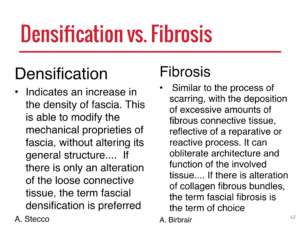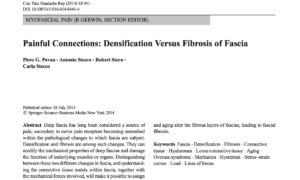by Mitch Hauschildt, MA, ATC, CSCS
A topic that always brings with it a lot of questions and debate in the courses that I teach the concept of looking at densified tissue vs. fibrotic tissue. I don’t consider myself an expert in the field, but I have learned a few things on this topic and recently read an article that clarified some things for me on the differences between the two.
As I understand it right now (and I always reserve the right to change my opinion as I learn new information), fibrosis is similar to what we traditionally think of as scarring. It is when the body lays down new tissue in an area in response to a disruption. This process process involves the alteration of collagen fibrous bundles and usually takes several weeks to occur. A fibrosis also usually involves tissue being laid down in a variety of directions and planes. It usually occurs in response to trauma, surgery and/or diabetes. A fibrosis is difficult to deal with from a therapeutic perspective, because it is a true structural change and can cause a great deal of problems with function.
Densification occurs when the loose connective tissue that lies between fascial layers has become thickened (densified) and no longer allows fascia to slide and glide the way that they are intended. In this scenario, the fascia continues to possess the same properties as all other fascia, including mechanoreception and perception. It is thought that these layers of fascia, along with the loose connective tissue, actually become more dense in a specific area, but there is no evidence of new fibrotic tissue being deposited. Thus the term densification rather than fibrosis. Densification usually occurs in response to poor diet, bad movement patterns and overused syndromes. They can also be problematic, but because it isn’t a true structural change, densified tissue is usually easier to deal with than a fibrosis.
Many people use the two terms interchangeably, but I believe that it is important that we know the difference because it will likely change our treatment approach.
The literature is now supporting the concept that fibrosis doesn’t occur as often as we have traditionally thought that it does. We have been led to believe that when we feel restrictions under the skin that those restrictions are due to fibrosis (or scarring) under the skin. What diagnostic testing, such as ultrasound, is revealing under the skin, is that most of these restrictions are actually due to densified tissue. A product of poor tissue slide and glide among the fascial layers.
The proposed solution for these restrictions has been to beat up the tissue to “break up the adhesions.” The great thing about a densification is that because it is made up of normal fascial tissue, it responds very well to a mechanical stimulus. Meaning, when touched, it will change tone in response to rate, depth, and direction. This change in tone, coupled with improved viscosity in Hyaluronic Acid, will improve how the layers function and interact, ultimately leading to improved movement.
Don’t get me wrong, it’s not that I believe that a fibrosis doesn’t or can’t occur. I just now believe that it occurs at a much lower rate than we understood previously. This means that interventions are much easier and more effective.
When we first encounter a restriction under the skin, we need to assess the skin glide in multiple directions and vectors. Work through those restrictions with purpose and with a light touch. Focus on improving slide and glide first. If that treatment approach doesn’t work, you can explore other options that may involve a more mechanical approach to a correction. We know that less is more, so treat things as a densification until proven otherwise because is much more likely what is happening anyway.

For more information on this subject, I suggest you read this article.


Leave a Reply